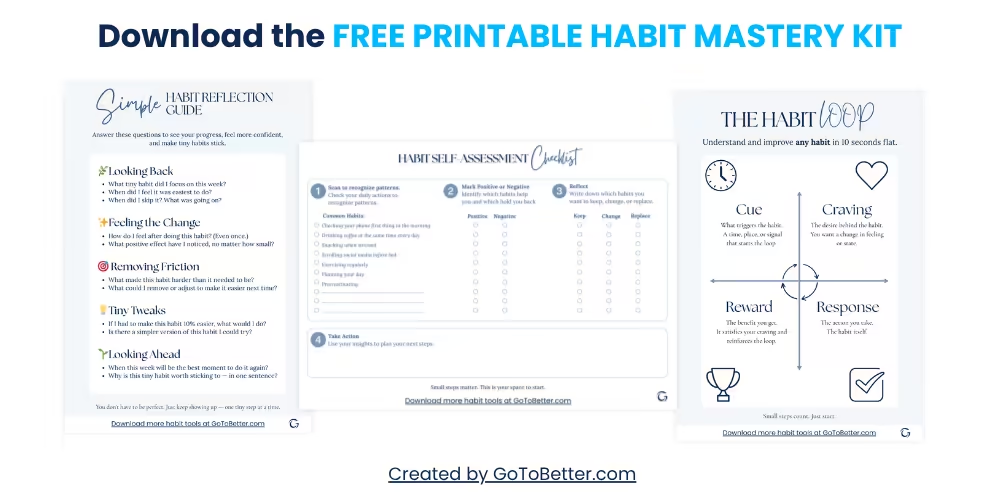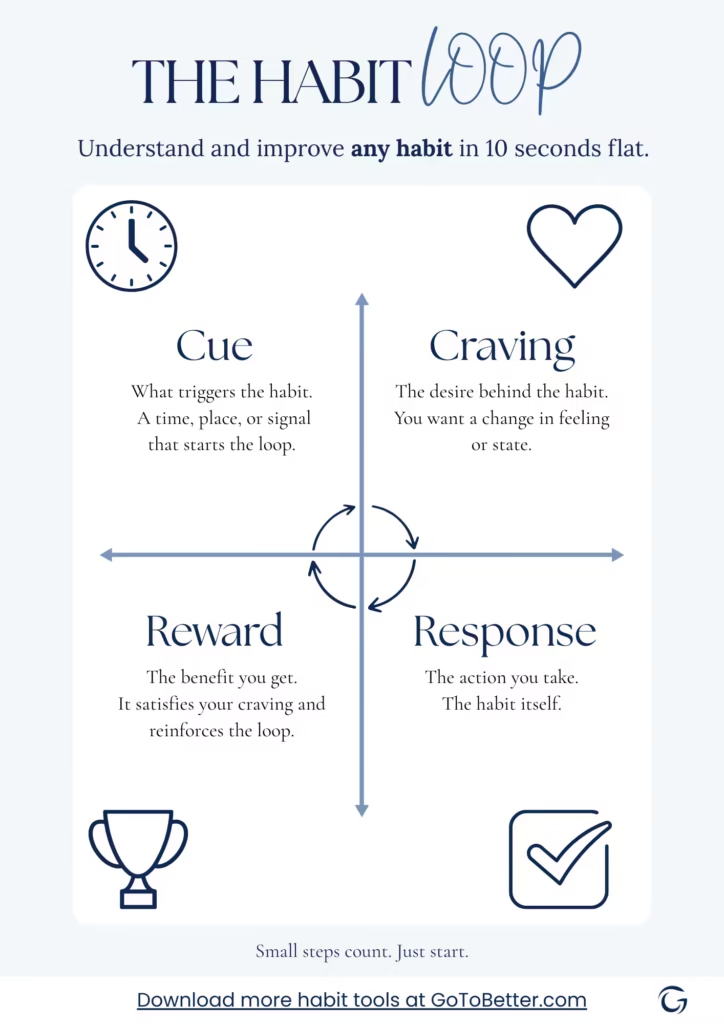+Free Habit Mastery Kit – Printable Reflection Guide & Checklist
The habit cycle explains how cues, routines, and rewards make behaviors automatic—whether you’re curious why you act on autopilot or want to see where your patterns begin. This guide covers clear examples, common myths, and science-backed insights.
By GoToBetter | Tested by real life, not just theory
Understanding the Habit Cycle
Look, you don’t have to change anything yet.
Sometimes the most helpful thing is just to see the pattern for what it is—a cycle of cue, routine, and reward that repeats itself whether you notice or not.
When you can name each part, you have options. Not to fix everything at once, but to understand why you keep reaching for your phone, why that afternoon snack happens, or why you feel pulled into the same reaction over and over.
Before you keep reading, you might want something you can hold in your hands. The Free Habit Mastery Kit includes:
- A self-assessment checklist to spot hidden habits
- A visual explainer of the Habit Loop (like the one you’ll see below)
- A reflection guide to track your own patterns over time
No pressure. Just clear tools to help you see what’s really happening.
Write your email and get your Free Kit here↓

What Is the Habit Cycle?
The habit cycle is a repeating process your brain uses to save energy and make decisions faster. In this four-part model, every habit begins with a cue, creates a craving, triggers a response, and ends with a reward. Together, these steps form a self-reinforcing loop that can run quietly in the background of your life.
You might have first heard of this idea from Charles Duhigg’s The Power of Habit, which introduced a three-step version. But many researchers and practitioners now agree that adding craving as its own phase helps explain why certain behaviors feel irresistible.
Think about how you always feel like checking your phone when you see a notification light. The cue (the blinking light) isn’t enough by itself. It’s the craving — the anticipation of connection or relief — that makes you act.
Below is a diagram of the habit loop with all four elements clearly marked. Keep it in mind as you read; understanding this visual helps you see where your own habits begin.

Some mornings, it feels like you’re just following a script. You wake up, see your phone (cue), feel a tug of curiosity (craving), open your inbox (response), and get a little hit of certainty or distraction (reward). Repeat it often enough, and you don’t even notice it’s happening.
GoToBetter says it like this: “A habit is just a decision repeated until your brain stops asking.”
The Four Parts of the Habit Cycle
Let’s look more closely at each of the four steps. Many articles gloss over these details, but understanding them is the only way to see why habits feel so powerful.
Cue
The cue is the trigger that signals your brain to start the loop. It could be external (like the time of day or a place) or internal (like a feeling). For example, driving past your favorite café can cue the urge for coffee even if you weren’t planning to stop.
Cues often feel harmless until you notice how consistently they spark the same craving. That’s why identifying them is a cornerstone of behavior change science.
Craving
Craving is the emotional or mental desire that makes the habit feel urgent. It’s the tension between where you are and the relief or pleasure you expect.
Imagine walking into your kitchen late at night. You’re not hungry. But you feel a craving for comfort or distraction. The craving fuels the habit reinforcement that keeps the loop strong.
Craving is the reason a cue doesn’t stay neutral. It’s what turns a passing thought into an almost automatic reaction.
Response
The response is the behavior itself—the action you take to satisfy the craving. This could be a visible action (like eating a snack), a mental habit (like rumination), or an emotional reaction (like snapping at someone).
Many people only notice this part of the loop. But trying to change the response without understanding what sparked it rarely works.
Reward
The reward is the outcome your brain uses to decide if the loop is worth repeating. It’s the payoff—feeling calm, energized, connected, or entertained.
Even small rewards matter. A tiny sense of relief can be enough to cement a pattern.
When the reward consistently delivers on the craving, the loop strengthens. This is how automatic behavior patterns form over time.
GoToBetter InsightCravings drive habits more than rewards. Without desire, cues are just signals—nothing more.
Why the Cycle Feels Automatic
If you’ve ever pulled into your driveway and realized you remember nothing about the trip, you’ve seen how automatic the habit cycle can become. Once a loop is reinforced enough times, it moves from conscious choice to reflex.
Your brain does this to conserve energy. Every time you repeat the same cue-craving-response-reward pattern, you carve a deeper groove. Over time, it becomes easier to follow the groove than to choose a different path.
Behavior change science calls this process “automaticity.” Research has shown that about 40–45% of what you do each day is driven by these loops.
Even when you make a plan to act differently, a familiar cue can trigger the old craving so fast that your intentions never get a chance.
GoToBetter says it like this: “Cues don’t ask for permission—they trigger action automatically.”
Imagine you sit down at your desk. Before you even think, you open email. The cue (sitting down), craving (wanting to feel in control), response (checking messages), and reward (certainty) all fire in sequence. This is why breaking the habit cycle requires more than willpower.
How the Cycle Evolves Over Time
One myth is that habits are fixed once they form. In reality, your loops adapt constantly. New environments disrupt cues. Changing priorities dull cravings. Even the reward can fade over time.
Imagine you always ran after work (response) to unwind (reward). Then you switched jobs, and your commute changed. The cue (arriving home) isn’t at the same time. You start feeling tired instead of motivated. Gradually, the habit weakens.
Sometimes, the loop doesn’t disappear—it simply changes shape. A smoker might replace lighting a cigarette with scrolling social media, but the craving for relief stays the same.
| Stage | How It Changes | Effect on Behavior |
|---|---|---|
| Cue | New environment removes old signals | Loop weakens or dissolves |
| Craving | Motivation shifts to a new desire | Loop finds different rewards |
| Response | Behavior swaps to a similar action | Loop adapts but survives |
| Reward | Outcome loses relevance | Loop loses reinforcement |
This is why even long-standing routines sometimes dissolve on their own. Life changes, and the pattern no longer fits.
Common Myths About the Habit Cycle
A lot of popular advice about habits skips nuance. Here are a few ideas worth reconsidering.
Myth 1: Habits form in exactly 21 days.
In reality, research shows it takes anywhere from 18 to 254 days, depending on the behavior and consistency.
Myth 2: You need big rewards.
Small rewards—a sigh of relief, a moment of pleasure—are often enough to strengthen the loop.
Myth 3: Cues are always obvious.
Many cues are subtle: the feeling of boredom, a time of day, or a fleeting memory.
Myth 4: Habits never change once formed.
Life transitions, new environments, or shifts in identity can weaken or break even old patterns.
Myth 5: All habits are conscious choices.
Most run beneath awareness—until you look closely.
GoToBetter InsightMost habits feel inevitable because they’re invisible. The first step isn’t change—it’s seeing the loop clearly.
When you can name each part—cue, craving, response, reward—it stops feeling mysterious. And that clarity is often the starting point for any change.
GoToBetter Mini Tool: Spot Your Habit Loop
Take one minute to map out a single habit you do automatically. No overthinking—just write down what comes to mind.
- Choose a behavior you repeat often (e.g., checking your phone).
- Write the cue that usually triggers it (time, place, feeling).
- Describe the craving you feel (boredom, curiosity, relief).
- Note the response you do next.
- Write the reward you get, even if it’s small.
Look at your notes—this is your habit cycle in real life.
Want to Keep Going? Here’s What Helps
This article is part of the GoToBetter Habit Foundations Series — a clear, no-fluff guide to understanding why your habits feel automatic.
If you want the bigger picture, you can start here:
Read The Ultimate Guide to What Are Habits — it explains how habits form, adapt, and shape nearly half your daily choices.
Or, if you prefer to dive right into reflection, you can grab the Free Habit Mastery Kit — no sign-ups beyond your email, no app required:
- A printable self-assessment checklist
- A visual habit loop explainer
- A simple progress tracking guide
Want a clear starting point? Download your Free Habit Mastery Kit and keep it close — it’s your first step toward understanding your own patterns.
Habit Cycle FAQ
What is the habit cycle?
The habit cycle is a four-step loop: cue, craving, response, reward. This process helps your brain automate actions over time. For example, seeing your phone (cue) creates curiosity (craving), you check it (response), and feel informed (reward).
How long does it take to form a habit cycle?
Research suggests habits can take anywhere from 18 to 254 days to feel automatic. Simpler behaviors like drinking water may form faster than complex routines. Consistency matters more than speed.
How can I identify my own cues?
Start by noticing what happens right before the habit. Is it a time of day, an emotion, or a place? For example, if you snack at night, the cue might be boredom after dinner. Writing these down helps make patterns visible.
Does the reward have to be big?
No. Even a small reward—like a moment of relief or pleasure—can reinforce the loop. What’s important is that it feels satisfying enough to repeat. Over time, the craving and response pair with the reward automatically.
Can the habit cycle be broken?
Yes, but it usually requires disrupting one or more parts of the loop. Removing the cue, changing the craving, or replacing the response can weaken the cycle. For example, moving your phone away at night removes the automatic trigger.
Ready to Go Deeper?
When understanding your habits starts to feel grounding — not overwhelming — you might be ready to build something more complete.
That’s where the GoToBetter printable trackers and journals come in. They’re designed for real-life rhythms (and real-life chaos). You’ll find:
- Simple trackers to map your habits over time
- Guided journals to reflect without overthinking
- Tools that help you see patterns without judgment
Explore the full collection in the GoToBetter Shop — from quick daily check-ins to full reflection systems.


Having read this I thought it was rather enlightening. I appreciate you finding the time and effort to put this
informative article together. I once again find myself personally spending a lot of time
both reading and leaving comments. But so what, it
was still worth it!